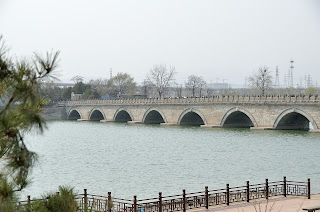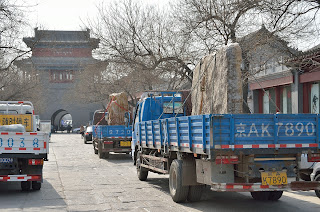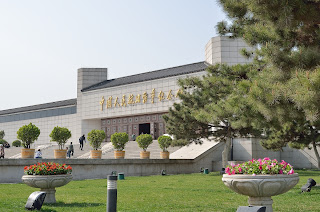A couple of weeks ago Margot and I visited Lugou Qiao or Marco Polo Bridge in southwest Beijing.
The bridge was constructed in 1189.
In Marco Polo's Diary he said, "Over this river there is a very fine stone bridge, so fine indeed, that it has very few equals in the world." Although, there are some who don't think Marco Polo actually made it all the way to Beijing.
The lions are said to be too numerous to count. There are apparently about 485 lions lining both sides of the bridge. Some have been replaced over the years. This one looks to be relatively new.
This is one of the older ones. It is said that they are all different.
The structure in the background is the gate into Wanping fortress. Wanping dates to the 17th century. Of course, now Beijing has completely engulfed it.
The bridge is on a strategic route to Beijing from the south.
The flag belongs to a tour group. We got there by taking the subway to Wukesong and then taking a taxi to the bridge.
The area between the bridge and Wanping is a park. There are a number of sculptures describing the building of the bridge. The bridge was build of solid marble without cranes or power tools.
These two guys were enjoying the sunshine.
The park is actually an overpass over the 5th ring road, but you would never know it.
This picture is inside Wanping. It is a small village now.
These guys are doing some renovation and upgrading work.
Wanping is the site of the Memorial Museum of the Chinese People's Anti - Japanese War. This location was chosen because the bridge was the site of the first shots of the War of Resistance on July 7, 1937.
The picture is some of the leaders of the war. Mao is second from the right. There is a lot of English and Japanese in the descriptions so it is pretty easy to follow along. However, I don't imagine they get too many Japanese visitors. See a couple down for an explanation.
Here is what the bridge looked like in 1937.
I couldn't resist adding this one. I don't remember why this one was there. I imagine it had to do with the tools used in the war effort. Ironically, this looks like a Japanese slide rule.
There is quite a bit of space dedicated to Japanese war atrocities. The official number is 300,000 murdered in Nanjing.
Here is a Japanese torture device. The inside is lined with nails. Use your imagination on how it worked.
Some very gruesome pictures that are hard to look at.
Here is something more positive. It is an x-ray machine made by Fisher in Chicago and purchased by overseas Chinese and shipped to China by the US Army.



















No comments:
Post a Comment